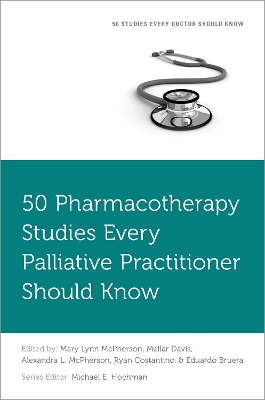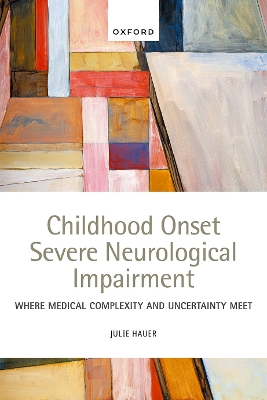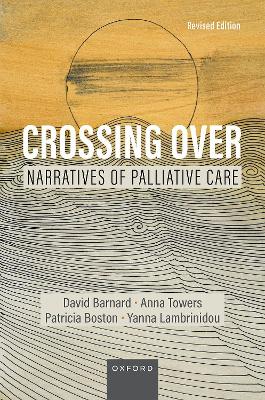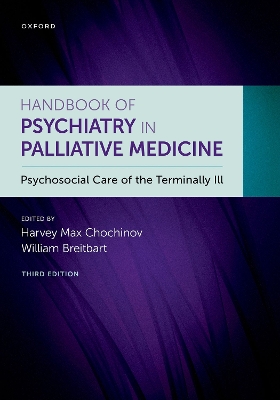Voluntarily Stopping Eating and Drinking
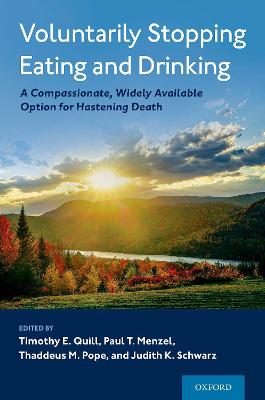 -10%
portes grátis
-10%
portes grátis
Voluntarily Stopping Eating and Drinking
A Compassionate, Widely-Available Option for Hastening Death
Pope, Thaddeus; Schwarz, Judith K.; Menzel, Paul T.; Quill, Timothy E.
Oxford University Press Inc
10/2021
312
Dura
Inglês
9780190080730
15 a 20 dias
592
Preface
Acknowledgments
Contributors
Introduction
Part I. Voluntarily Stopping Eating and Drinking (VSED) by People with Decision-Making Capacity
1. Illustrative Cases
1.1 Al (Amyotrophic Lateral Sclerosis): Looking for Options to Hasten Death
1.2 Bill (Breast Cancer): Preference for Medical Aid in Dying
1.3 Mrs. H. (Early Alzheimer's Disease): How Best to Time VSED
1.4 G.W. (Lung Cancer): Family and Staff Conflict
2. Clinical Issues
2.1 Background IssuesDLPalliative Care and Hospice
2.2. Background IssuesDLUnacceptable Suffering and Deterioration
2.3 Evaluation of Requests for VSED
2.4 VSEDDLKey Practical Matters to Consider in Advance
2.5 Requirements to Initiate VSED for Patients with Decision-Making Capacity
2.6 Formal Advance Care Planning
2.7 Managing Symptoms and Complications Once VSED Is Initiated
2.8 Impact of Culture on VSED
2.9 Advantages of VSED as an Option to Achieve a Desired Death
2.10 Disadvantages and Challenges of VSED as an Option to Achieve a Desired Death
2.11 Revisiting the Initial Cases
3. Ethical Issues
3.1 Introduction
3.2 Refusing Lifesaving Treatment
3.3 Suicide
3.4 A Different Comparison: Medical Aid in Dying
3.5 Information, Encouragement, Persuasion
3.6 Conclusions
3.7 Ethical Issues Review of Initial Cases
4. Legal Issues
4.1 Introduction
4.2 VSED Is Widely Perceived to Be Legal
4.3 A Patient's Right to VSED Is Settled Law
4.4 Right to Refuse Includes the Right to VSED
4.5 Assisted Suicide Laws Generally Do Not Apply
4.6 Abuse and Neglect Laws Generally Do Not Apply
4.7 Other Issues for Patients and FamiliesDLLife Insurance
4.8 Other Issues for CliniciansDLInformed Consent
4.9 Other Issues for CliniciansDLConscience- Based Objections
4.10 Revisiting the Initial Cases
5. Institutional Issues
5.1 Introduction
5.2 Published Data on Patient Experience of VSED in Institutional Settings
5.3 Institutional Barriers to VSED
5.4 Variations in State Laws around Resident Rights
5.5 Role of Hospice in Buffering Conflicts Between Interests of Resident and LTC Facility
5.6 Approach to Care of Persons Requesting VSED in Institutional Settings
5.7 Specific Care Issues for Residents Who VSED in Institutional Settings
5.8 Moral Distress and Conscience-Based Objections
5.9 ConclusionDLInstitutional Care Issues
5.10 Case Comments from an Institutional Perspective
6. Best Practices, Enduring Challenges, and Opportunities for VSED
6.1 Best Practices
6.2 Enduring Challenges
6.3 Opportunities
Part II. Stopping Eating and Drinking by Advance Directive (SED by AD) for Persons Without Decision-Making Capacity
7. Illustrative Cases
7.1 Mrs. H. (Early Alzheimer's): Speculation about the Challenge of Waiting
7.2 Steve (Early Dementia): Patient and Family Challenges
7.3 Patricia (Moderate Dementia): Hastening Death by SED versus Preemptive Suicide
7.4 Charles (Severe Dementia): No Assistance with Oral Feeding
8. Clinical Issues
8.1. General Approach When Capacity Is Lost
8.2. Background Issues
8.3. Advance Care Planning
8.4. Practical Aspects of Stopping Eating and Drinking by Advance Directive (SED by AD) and Comfort Feeding Only (CFO)
8.5. Limits of Palliation with Comfort Feeding Only (CFO)
8.6. Advantages of SED by AD
8.7. Disadvantages of SED by AD
8.8. Return to the Cases
9. Ethical Issues
9.1 Introduction
9.2 Change of Mind
9.3 Is Feeding Fundamentally Different?
9.4 Burdens of Survival on Family and Family Caregivers
9.5 Caregiver and Proxy Distress
9.6 The Odds of Implementation and the Attraction of Preemptive Measures
9.7 Comparison with Comfort Feeding Only
9.8 Conclusions
9.9 Ethical Issues Review of Initial Cases
10. Legal Issues
10.1 Introduction
10.2 There Is Little On-Point Precedent
10.3 Draft the Advance Directive Carefully
10.4 Non-Statutory Advance Directives Potentially Allow SED by AD
10.5 Some Advance Directive Statutes Permit SED by AD
10.6 Many Advance Directive Statutes Require Triggering Conditions
10.7 Circumventing Home State Law with Reciprocity Rules
10.8 Inadvertent Revocations and Vetoes
10.9 Ulysses Clauses May Solve the Incapacitated Revocation Problem
10.10 Appointed Health Care Agents
10.11 Default Surrogates and Guardians
10.12 Conscience Based Objection
10.13 Conclusion
10.14 Return to the Cases
11. Institutional Issues
11.1. Introduction
11.2. "Dementia Worry" Is Common in Older Adults
11.3. Challenges of SED by AD in Advanced Dementia Are Most Apt to Manifest in Institutional LTC Settings
11.4. Resistance to Implementation of Dementia Directives Limiting Oral Nutrition and Hydration in LTC Settings
11.5. Ethical Rationale for Dementia Directives Limiting Oral Nutrition and Hydration in LTC Settings
11.6. ConclusionDLADs for SED in Institutional LTC Settings
11.7. Case Comments from an Institutional Perspective
12. Best Practices, Enduring Challenges, and Opportunities for SED by AD
12.1 Best Practices
12.2 Enduring Challenges
12.3 Opportunities
Appendices
A. Recommended Elements of an Advance Directive for Stopping Eating and Drinking (AD for SED)
B. Sample Advance Directives for SED
C. Cause of Death on Death Certificates with VSED or SED by AD
D. Position Statements and Clinical Guidance
E. Personal Narratives
F. Glossary
Index
Preface
Acknowledgments
Contributors
Introduction
Part I. Voluntarily Stopping Eating and Drinking (VSED) by People with Decision-Making Capacity
1. Illustrative Cases
1.1 Al (Amyotrophic Lateral Sclerosis): Looking for Options to Hasten Death
1.2 Bill (Breast Cancer): Preference for Medical Aid in Dying
1.3 Mrs. H. (Early Alzheimer's Disease): How Best to Time VSED
1.4 G.W. (Lung Cancer): Family and Staff Conflict
2. Clinical Issues
2.1 Background IssuesDLPalliative Care and Hospice
2.2. Background IssuesDLUnacceptable Suffering and Deterioration
2.3 Evaluation of Requests for VSED
2.4 VSEDDLKey Practical Matters to Consider in Advance
2.5 Requirements to Initiate VSED for Patients with Decision-Making Capacity
2.6 Formal Advance Care Planning
2.7 Managing Symptoms and Complications Once VSED Is Initiated
2.8 Impact of Culture on VSED
2.9 Advantages of VSED as an Option to Achieve a Desired Death
2.10 Disadvantages and Challenges of VSED as an Option to Achieve a Desired Death
2.11 Revisiting the Initial Cases
3. Ethical Issues
3.1 Introduction
3.2 Refusing Lifesaving Treatment
3.3 Suicide
3.4 A Different Comparison: Medical Aid in Dying
3.5 Information, Encouragement, Persuasion
3.6 Conclusions
3.7 Ethical Issues Review of Initial Cases
4. Legal Issues
4.1 Introduction
4.2 VSED Is Widely Perceived to Be Legal
4.3 A Patient's Right to VSED Is Settled Law
4.4 Right to Refuse Includes the Right to VSED
4.5 Assisted Suicide Laws Generally Do Not Apply
4.6 Abuse and Neglect Laws Generally Do Not Apply
4.7 Other Issues for Patients and FamiliesDLLife Insurance
4.8 Other Issues for CliniciansDLInformed Consent
4.9 Other Issues for CliniciansDLConscience- Based Objections
4.10 Revisiting the Initial Cases
5. Institutional Issues
5.1 Introduction
5.2 Published Data on Patient Experience of VSED in Institutional Settings
5.3 Institutional Barriers to VSED
5.4 Variations in State Laws around Resident Rights
5.5 Role of Hospice in Buffering Conflicts Between Interests of Resident and LTC Facility
5.6 Approach to Care of Persons Requesting VSED in Institutional Settings
5.7 Specific Care Issues for Residents Who VSED in Institutional Settings
5.8 Moral Distress and Conscience-Based Objections
5.9 ConclusionDLInstitutional Care Issues
5.10 Case Comments from an Institutional Perspective
6. Best Practices, Enduring Challenges, and Opportunities for VSED
6.1 Best Practices
6.2 Enduring Challenges
6.3 Opportunities
Part II. Stopping Eating and Drinking by Advance Directive (SED by AD) for Persons Without Decision-Making Capacity
7. Illustrative Cases
7.1 Mrs. H. (Early Alzheimer's): Speculation about the Challenge of Waiting
7.2 Steve (Early Dementia): Patient and Family Challenges
7.3 Patricia (Moderate Dementia): Hastening Death by SED versus Preemptive Suicide
7.4 Charles (Severe Dementia): No Assistance with Oral Feeding
8. Clinical Issues
8.1. General Approach When Capacity Is Lost
8.2. Background Issues
8.3. Advance Care Planning
8.4. Practical Aspects of Stopping Eating and Drinking by Advance Directive (SED by AD) and Comfort Feeding Only (CFO)
8.5. Limits of Palliation with Comfort Feeding Only (CFO)
8.6. Advantages of SED by AD
8.7. Disadvantages of SED by AD
8.8. Return to the Cases
9. Ethical Issues
9.1 Introduction
9.2 Change of Mind
9.3 Is Feeding Fundamentally Different?
9.4 Burdens of Survival on Family and Family Caregivers
9.5 Caregiver and Proxy Distress
9.6 The Odds of Implementation and the Attraction of Preemptive Measures
9.7 Comparison with Comfort Feeding Only
9.8 Conclusions
9.9 Ethical Issues Review of Initial Cases
10. Legal Issues
10.1 Introduction
10.2 There Is Little On-Point Precedent
10.3 Draft the Advance Directive Carefully
10.4 Non-Statutory Advance Directives Potentially Allow SED by AD
10.5 Some Advance Directive Statutes Permit SED by AD
10.6 Many Advance Directive Statutes Require Triggering Conditions
10.7 Circumventing Home State Law with Reciprocity Rules
10.8 Inadvertent Revocations and Vetoes
10.9 Ulysses Clauses May Solve the Incapacitated Revocation Problem
10.10 Appointed Health Care Agents
10.11 Default Surrogates and Guardians
10.12 Conscience Based Objection
10.13 Conclusion
10.14 Return to the Cases
11. Institutional Issues
11.1. Introduction
11.2. "Dementia Worry" Is Common in Older Adults
11.3. Challenges of SED by AD in Advanced Dementia Are Most Apt to Manifest in Institutional LTC Settings
11.4. Resistance to Implementation of Dementia Directives Limiting Oral Nutrition and Hydration in LTC Settings
11.5. Ethical Rationale for Dementia Directives Limiting Oral Nutrition and Hydration in LTC Settings
11.6. ConclusionDLADs for SED in Institutional LTC Settings
11.7. Case Comments from an Institutional Perspective
12. Best Practices, Enduring Challenges, and Opportunities for SED by AD
12.1 Best Practices
12.2 Enduring Challenges
12.3 Opportunities
Appendices
A. Recommended Elements of an Advance Directive for Stopping Eating and Drinking (AD for SED)
B. Sample Advance Directives for SED
C. Cause of Death on Death Certificates with VSED or SED by AD
D. Position Statements and Clinical Guidance
E. Personal Narratives
F. Glossary
Index


